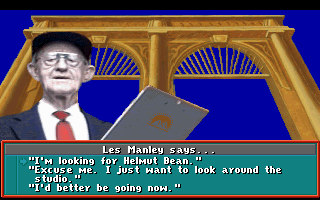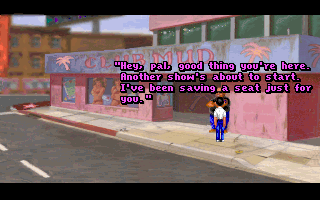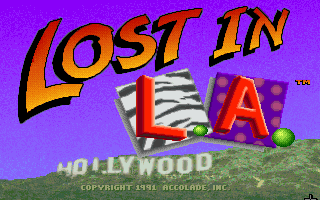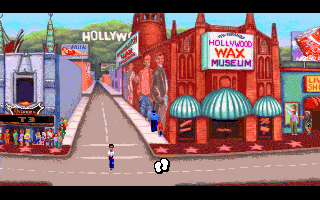Retro Replay Review
Gameplay
Les Manley in: Lost in L.A. marks a significant shift from its predecessor by embracing a pure point-and-click interface. Gone is the text parser, replaced with an intuitive system that highlights interactive objects with a question mark when you hover your mouse pointer over them. Clicking brings up a straightforward action menu, allowing you to pick from verbs like “use,” “look,” or “talk,” streamlining your interactions and keeping the focus on exploration and puzzle solving.
The inventory system follows the same principle: items you pick up appear in a bar at the bottom of the screen and can be used on environmental objects or characters in any scene. While this design choice eliminates the frustrating trial-and-error of combining random inventory items, it also means that puzzles are more focused and, at times, quite linear. Those who enjoy logical, almost hand-holding guidance will appreciate the clarity, but veteran adventure gamers seeking more convoluted brainteasers may find the challenge level modest.
Dialogue sequences are similarly structured: instead of freeform typing, you choose from preset lines that steer conversations forward. Because the narrative is tightly scripted, there’s no risk of locking yourself out by making the wrong conversational choice. As the story progresses, you even gain control of a second character, which injects fresh perspective into puzzle design and keeps the gameplay feeling dynamic throughout.
Graphics
The visual style of Lost in L.A. blends cartoonish backgrounds with digitized footage of actors, creating a quirky, almost comic-book aesthetic. Environments are richly detailed, from Helmut’s sprawling mansion to the neon-lit streets of Hollywood, and the bright color palette reinforces the game’s lighthearted tone. Background art often hides cleverly placed clues, encouraging close inspection as you hunt for your next objective.
Character portraits and cutscenes leverage simple digitized animations, giving the game a slightly surreal feel. While the resolution and frame rate may feel dated by modern standards, there’s undeniable charm in seeing real actors lip-sync with pixelated avatars. These live-action snippets are short but memorable, punctuating key moments in the plot with humorous gestures or exaggerated reactions.
On the technical side, the game runs smoothly on its intended hardware, with minimal load times between scenes. Transition effects—like sliding panoramas or fade-ins—are straightforward but effective, maintaining immersion without overstaying their welcome. Overall, the graphical presentation strikes a balance between dated retro flair and playful creativity.
Story
Les Manley’s latest adventure kicks off when his best friend Helmut the Human Bean and Helmut’s girlfriend LaFonda Turner vanish from Helmut’s lavish Los Angeles mansion. Their disappearance is just the tip of the iceberg: a wave of celebrity kidnappings has swept Tinseltown, and no ransom notes have been found. As Les, you race against time to piece together clues, interview strange suspects, and unravel a conspiracy that lies behind Hollywood’s glitz.
The narrative unfolds in a series of episodic vignettes, each introducing new characters—ranging from shady agents to eccentric filmmakers—who may or may not be involved in the mass abductions. You’ll question motives, gather evidence, and occasionally switch to the secondary protagonist for a fresh viewpoint on the mystery. Despite its linear structure, the story is peppered with witty dialogue and tongue-in-cheek references to celebrity culture, ensuring that each conversation feels engaging rather than repetitive.
Although you’re never in danger of failing the story by choosing the “wrong” dialogue option, the branching choices you make during conversations can yield extra tidbits of information or sprinkle in comedic asides. The plot’s pacing is steady, gradually raising stakes until the final act reveals the mastermind behind the disappearances. Fans of campy mysteries and satirical takes on Hollywood will find plenty to enjoy in Les’s escapade.
Overall Experience
Les Manley in: Lost in L.A. is a crowd-pleaser for fans of classic point-and-click adventures who appreciate humor and a straightforward puzzle structure. The switch away from a text parser makes the game more accessible to newcomers, while the digitized actors and vibrant backdrops inject personality into each scene. Even though the puzzles lean toward the linear side, they’re never so obscure that you’ll spend hours stuck—making the playthrough satisfying without veering into frustration.
The game’s charm lies in its balance of cartoonish visuals, witty writing, and the thrill of uncovering a bizarre Hollywood conspiracy. Whether you’re sneaking into movie studios, tailing suspicious directors, or piecing together ransom notes, there’s a consistent sense of momentum that carries you from one set piece to the next. The branching dialogue options and the momentary shift in playable characters add enough variety to prevent the experience from growing stale.
Ultimately, Lost in L.A. delivers a well-crafted, enjoyable adventure that stands as a strong successor to Search for the King. While it may not challenge hardcore puzzle veterans to their limits, it shines as an entertaining, character-driven romp through the underbelly of showbiz. If you’re in the mood for a lighthearted mystery filled with quirky suspects and playful banter, Les Manley awaits your detective skills in the City of Angels.
 Retro Replay Retro Replay gaming reviews, news, emulation, geek stuff and more!
Retro Replay Retro Replay gaming reviews, news, emulation, geek stuff and more!









Reviews
There are no reviews yet.